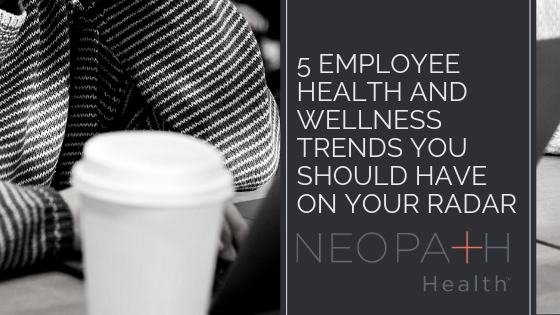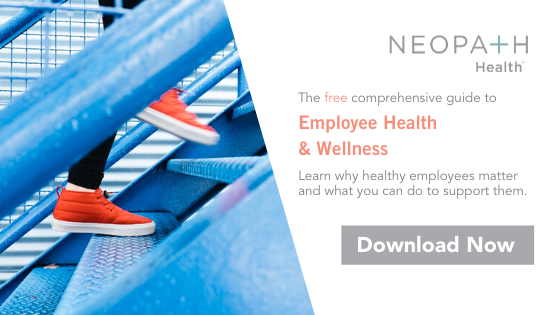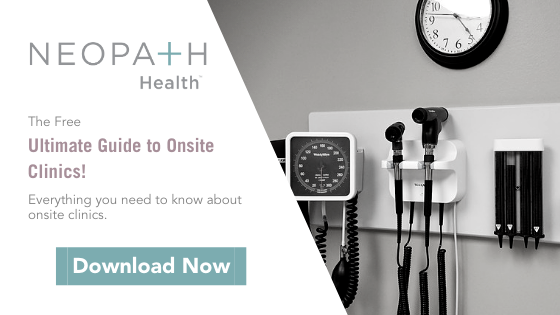Over the past few years, Americans have worked longer hours and been expected to produce more output than ever before. Many companies are trying to recognize how much they ask of their employees by investing in their personal health and wellness while at work and beyond. Here are 5 employee health and wellness trends you should have on your radar to boost workplace health.

Promotion of Self-care & Mindfulness at Work
Throughout the years there have been many practices to ensure employees are staying on task and not taking too many breaks or using company time for personal reasons. In recent years, that issue has been turned on its head by overworked employees becoming burnt out. They became too hyper-focused which has led to lower employee engagement and productivity, even if they are staying on task.
Why does employee health matter? Download our Employee Health and Wellness guide to learn more!
The issue of burnout can be a enormous impediment when you're trying to build a positive culture of workplace health. For that reason, another employee health and wellness trend is encouraging or even bringing in resources to teach employees self-care or mindfulness practices they can utilize at work. Employers should work to build a culture where it is acceptable for employees to take the breaks necessary to practice self-care and mindfulness. [Click here for tips on creating your wellness plan.]
Employees should focus on being fully present and engaged while working which may mean working for shorter periods of time than usual and taking more frequent, short breaks. Encourage your employees to practice short mindfulness exercises during this breaks.

Increased Workplace Flexibility & Encouraging Unplugging Outside of Work
Another growing trend in employee health and wellness is around offering flexible hours and remote work options, and it has been producing some promising results. A recent study by Zenefits reported that 73% of employees said flexible work arrangements increased their satisfaction at work, and 78% said it allowed them to be more productive.
Flexibility can mean providing hours outside of the "typical" 8-5 such as a later start time or allowing your employees the ability to decide their ideal hours. It could also be shortening a work week. Perhaps you have employees work a little longer day Monday through Thursday so they can take Friday off completely. Another excellent option for flexibility is to offer employees the option to work remotely. Some companies are starting to do this with limits of a certain numbers of times per week or month while others are diving in and letting employees keep their laptops with them and work from wherever they'd like.
A more recent flexible workplace health option is providing unlimited time off. This can be a bit nerve racking for a company because it is less predictable and can make employees a little nervous about not understanding how much is too much. There are also many upsides in that it releases your HR personnel from having to meticulously track and update PTO accruals and reduces the late-in-the-year rush to use up unused PTO. This option is about building understanding and trust around a new way of doing things.
The other side of the coin are the workplaces or positions that are "always on" or that require specific workers at specific times so flexibility just isn't an option. For these roles or worksites, the growing trend is to ensure employees are leaving work at work when they take off at the end of the day. Provide desktop computers that don't leave the office, don't allow email to be connected to a personal phone, and bring in resources to educate employees on the importance and benefits of unplugging from work and devices in general from time-to-time.
Expanding Beyond Physical Wellness (Including Mental Health & Financial Fitness)
A lot of workplaces over the years have realized the importance of physical fitness and have offered solutions such as fitness facilities or stipends, healthy snacks, a workplace masseuse or physical therapist, and onsite clinics. Some places are starting to understand that mental health and financial fitness are just as important to an employee's overall wellness as their physical fitness.
![]()
According to the Society for Human Resource Management (SHRM), the percentage of employers offering financial wellness programs rose to 83 percent in 2018, up from 20 percent in 2015. Offering financial wellness options has decreased the stress that employees feel regarding their finances, increased participation in retirement planning, as well as increased employee satisfaction and productivity.
A massive study of over 17,000 employees by Mental Health America found that 80% of employees stated that workplace stress affected their personal (outside of work) relationships, and 35% missed 3-5 days of work every month due to workplace stress. It also discovered that staff recognition and appreciation goes further with employees than monetary compensation, and things like flexible work options and a relaxed work environment led to higher rates of engagement and job satisfaction.
Increased Data & More Personalization
The employee health and wellness trend overall has caught the attention of the tech industry and the response has been massive. There are countless wearable devices and software that can be utilized to help track and manage personal wellness goals and progress. The amount of data being collected by these devices and solutions is exponential and is making it possible to make solutions more personalized than ever to an individual's specific habits and needs.
Using software solutions and technology to support you workplace health and wellness program can help personalize the offerings to your workforce leading to higher levels of engagement and enjoyment within the programs.
More Creativity and Consciousness in Wellness Offerings
With the overall focus on employee health and wellness growing every year and the unemployment levels continuing to drop, 2019 promises to be an interesting year of new developments as companies attempt to one-up each other to compete for the top talent. HR people will be provided with larger budgets and more resources to discover and implement the most competitive benefits offerings and a big piece of that will be employee health and wellness. Companies are putting more thought into figuring out exactly what their workforce needs to be their most productive and are using more creativity in how to fulfill those needs. A couple of ideas to get you started are offering monthly wellness classes to try out ideas and topics to teach anything from gut health to yoga.
.png?width=433&name=NeoPath_2019_logo_2color%20(1).png)




